Management Accounting Systems and Techniques
VerifiedAdded on 2023/01/04
|21
|4404
|58
AI Summary
This study focuses on management accounting systems and techniques prevalent in the UK. It explores different methods of management accounting reporting, techniques of cost analysis, and tools used in management accounting. The study aims to provide insights into how these systems and techniques can be implemented to improve financial performance.
Contribute Materials
Your contribution can guide someone’s learning journey. Share your
documents today.
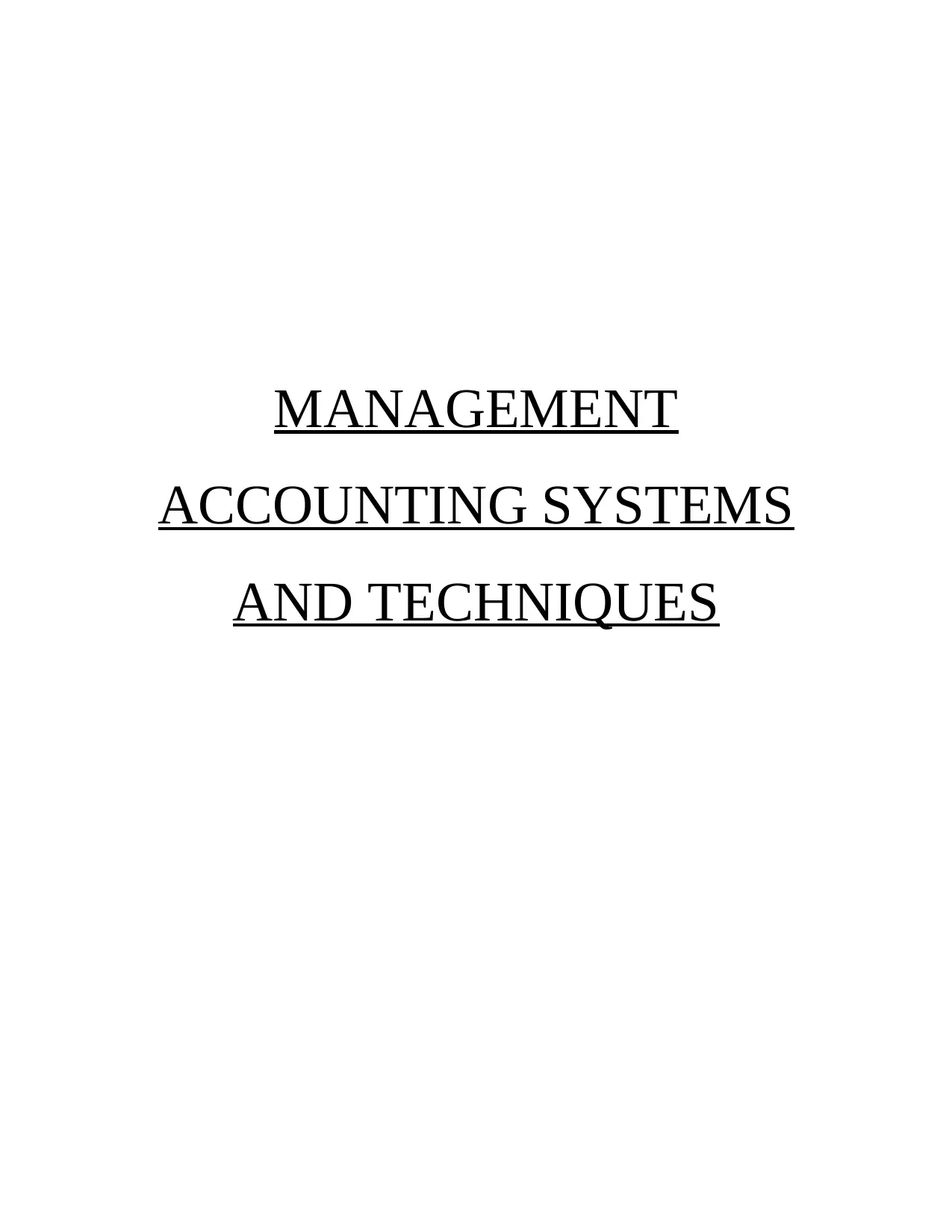
MANAGEMENT
ACCOUNTING SYSTEMS
AND TECHNIQUES
ACCOUNTING SYSTEMS
AND TECHNIQUES
Secure Best Marks with AI Grader
Need help grading? Try our AI Grader for instant feedback on your assignments.

Table of Contents
INTRODUCTION...........................................................................................................................3
P1 Management Accounting Systems.............................................................................................3
P2 Different methods of Management Accounting Reporting……………………………………5
P3 Techniques of cost analysis........................................................................................................6
P4 Tools and techniques used in management accounting............................................................10
P5 Comparison of companies responding to financial problems using management accounting.12
CONCLUSION..............................................................................................................................13
REFERENCES..............................................................................................................................14
INTRODUCTION...........................................................................................................................3
P1 Management Accounting Systems.............................................................................................3
P2 Different methods of Management Accounting Reporting……………………………………5
P3 Techniques of cost analysis........................................................................................................6
P4 Tools and techniques used in management accounting............................................................10
P5 Comparison of companies responding to financial problems using management accounting.12
CONCLUSION..............................................................................................................................13
REFERENCES..............................................................................................................................14
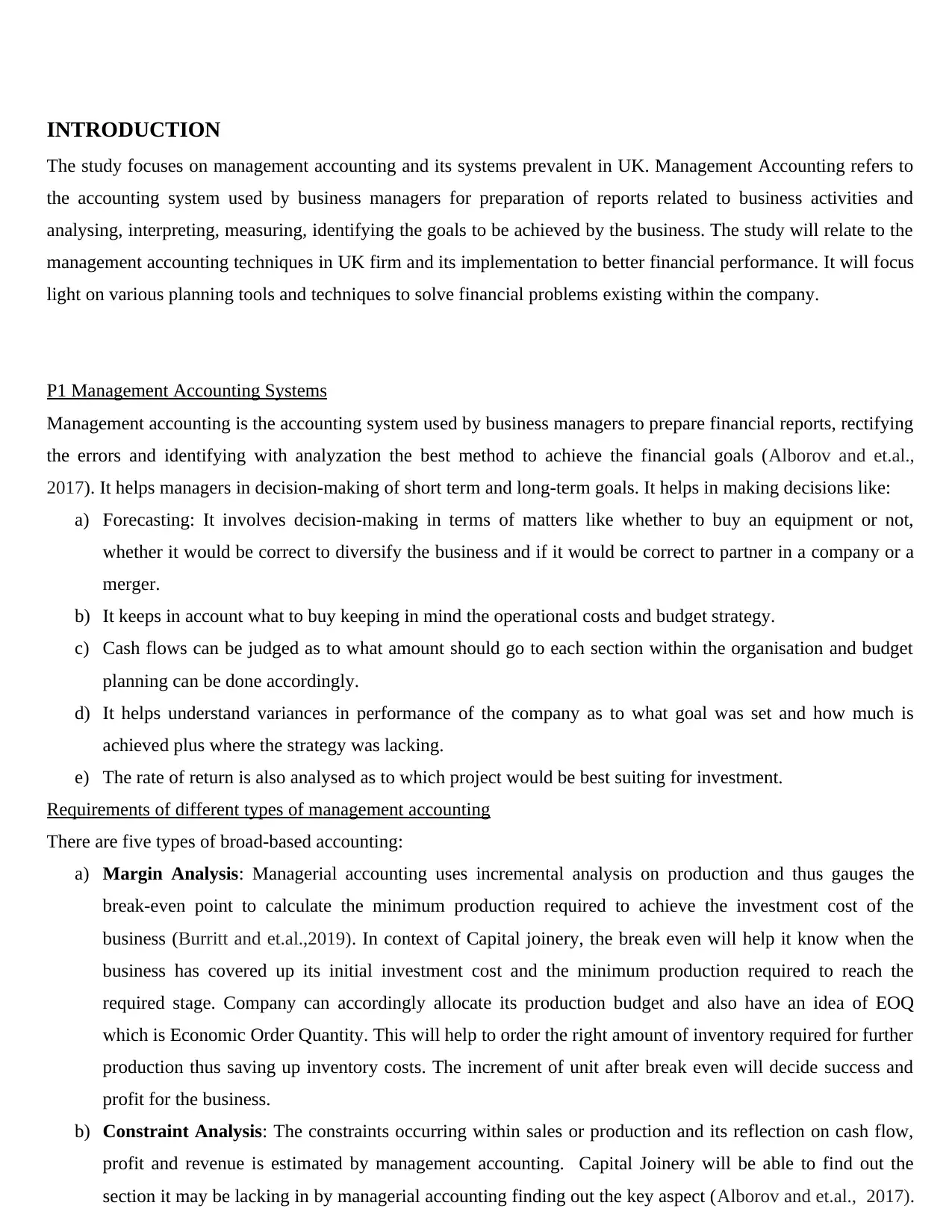
INTRODUCTION
The study focuses on management accounting and its systems prevalent in UK. Management Accounting refers to
the accounting system used by business managers for preparation of reports related to business activities and
analysing, interpreting, measuring, identifying the goals to be achieved by the business. The study will relate to the
management accounting techniques in UK firm and its implementation to better financial performance. It will focus
light on various planning tools and techniques to solve financial problems existing within the company.
P1 Management Accounting Systems
Management accounting is the accounting system used by business managers to prepare financial reports, rectifying
the errors and identifying with analyzation the best method to achieve the financial goals (Alborov and et.al.,
2017). It helps managers in decision-making of short term and long-term goals. It helps in making decisions like:
a) Forecasting: It involves decision-making in terms of matters like whether to buy an equipment or not,
whether it would be correct to diversify the business and if it would be correct to partner in a company or a
merger.
b) It keeps in account what to buy keeping in mind the operational costs and budget strategy.
c) Cash flows can be judged as to what amount should go to each section within the organisation and budget
planning can be done accordingly.
d) It helps understand variances in performance of the company as to what goal was set and how much is
achieved plus where the strategy was lacking.
e) The rate of return is also analysed as to which project would be best suiting for investment.
Requirements of different types of management accounting
There are five types of broad-based accounting:
a) Margin Analysis: Managerial accounting uses incremental analysis on production and thus gauges the
break-even point to calculate the minimum production required to achieve the investment cost of the
business (Burritt and et.al.,2019). In context of Capital joinery, the break even will help it know when the
business has covered up its initial investment cost and the minimum production required to reach the
required stage. Company can accordingly allocate its production budget and also have an idea of EOQ
which is Economic Order Quantity. This will help to order the right amount of inventory required for further
production thus saving up inventory costs. The increment of unit after break even will decide success and
profit for the business.
b) Constraint Analysis: The constraints occurring within sales or production and its reflection on cash flow,
profit and revenue is estimated by management accounting. Capital Joinery will be able to find out the
section it may be lacking in by managerial accounting finding out the key aspect (Alborov and et.al., 2017).
The study focuses on management accounting and its systems prevalent in UK. Management Accounting refers to
the accounting system used by business managers for preparation of reports related to business activities and
analysing, interpreting, measuring, identifying the goals to be achieved by the business. The study will relate to the
management accounting techniques in UK firm and its implementation to better financial performance. It will focus
light on various planning tools and techniques to solve financial problems existing within the company.
P1 Management Accounting Systems
Management accounting is the accounting system used by business managers to prepare financial reports, rectifying
the errors and identifying with analyzation the best method to achieve the financial goals (Alborov and et.al.,
2017). It helps managers in decision-making of short term and long-term goals. It helps in making decisions like:
a) Forecasting: It involves decision-making in terms of matters like whether to buy an equipment or not,
whether it would be correct to diversify the business and if it would be correct to partner in a company or a
merger.
b) It keeps in account what to buy keeping in mind the operational costs and budget strategy.
c) Cash flows can be judged as to what amount should go to each section within the organisation and budget
planning can be done accordingly.
d) It helps understand variances in performance of the company as to what goal was set and how much is
achieved plus where the strategy was lacking.
e) The rate of return is also analysed as to which project would be best suiting for investment.
Requirements of different types of management accounting
There are five types of broad-based accounting:
a) Margin Analysis: Managerial accounting uses incremental analysis on production and thus gauges the
break-even point to calculate the minimum production required to achieve the investment cost of the
business (Burritt and et.al.,2019). In context of Capital joinery, the break even will help it know when the
business has covered up its initial investment cost and the minimum production required to reach the
required stage. Company can accordingly allocate its production budget and also have an idea of EOQ
which is Economic Order Quantity. This will help to order the right amount of inventory required for further
production thus saving up inventory costs. The increment of unit after break even will decide success and
profit for the business.
b) Constraint Analysis: The constraints occurring within sales or production and its reflection on cash flow,
profit and revenue is estimated by management accounting. Capital Joinery will be able to find out the
section it may be lacking in by managerial accounting finding out the key aspect (Alborov and et.al., 2017).

It may be production where higher technique may be required to manufacture joinery items. Company will
have to bring in superior technology for this and hence accordingly a budget allocation will have to be
made. This will help company in removing constraints and improve production and revenue. Cash flow will
get affected on both sides as superior technology will demand more investment but it will be balanced by
sales increase due to better product quality and profit may come up after some time.
c) Capital Budgeting: The investment of a certain amount of capital on a project, equipment etc. is decided
and factors of time value of money and rate of return are taken into consideration. It also reviews the
demand of products and services and sets a financial chart for their purchase (Honggowati and et.al., 2017).
Capital Joinery will be able to make decision on project or investment on equipment which will be suitable
for the company to put their finances in. Methods used in management accounting of time value of money
and rate of return will help in making long term and short-term decisions. The demand of products from
suppliers and customers will also get in picture for the company and accordingly production can be done
thus saving excess costs.
d) Trend Analysis: Factors like historical pricing, sales volumes, demographic trends of customers,
geographical locations are taken into consideration. Capital Joinery can hugely benefit from these factors as
the demand and supply chart with revenue generation all will come up in statistical terms thus making it
easy to allocate budget for varied products according to the demand per se.
e) Product Costing: It helps in determining the cost of product making involving factor of raw materials,
production costs, overhead costs etc. Costs associated with inventory and their storage are also made
according to inventory taking up per square foot space. Capital Joinery through management accounting
will be able to price its products better after calculating all the production, material and overhead costs.
Excess costs in inventory management will too be accounted helping in gauging cash flow better.
P2 Different methods of Management Accounting Reporting
Management Accounting is reported in the following ways:
a) Budget Reporting: Budget consists of all the company’s earnings and expenditures upcoming in a
financial year. The various sections of organisation viz. marketing, HR, systems, finance are covered up
in it. Allotment of money is done seeing the previous budget allocated, the response achieved through it
and the current demands of the organisation (Burritt and et.al.,2019). A company tries to achieve its
goals in staying within the budgeted norms. Seeing the circumstances change in future, usually a
separate provision is added in the budget. Capital Joinery will get pre-estimate of how much to allocate
finance in which section, cost cutting can take place where managers feel excess amount is being used.
b) Account Receivables Report: An organisation has to extend credit in some orders as every order does
not generate instant payment. This is booked as account receivables in which money is pending for the
have to bring in superior technology for this and hence accordingly a budget allocation will have to be
made. This will help company in removing constraints and improve production and revenue. Cash flow will
get affected on both sides as superior technology will demand more investment but it will be balanced by
sales increase due to better product quality and profit may come up after some time.
c) Capital Budgeting: The investment of a certain amount of capital on a project, equipment etc. is decided
and factors of time value of money and rate of return are taken into consideration. It also reviews the
demand of products and services and sets a financial chart for their purchase (Honggowati and et.al., 2017).
Capital Joinery will be able to make decision on project or investment on equipment which will be suitable
for the company to put their finances in. Methods used in management accounting of time value of money
and rate of return will help in making long term and short-term decisions. The demand of products from
suppliers and customers will also get in picture for the company and accordingly production can be done
thus saving excess costs.
d) Trend Analysis: Factors like historical pricing, sales volumes, demographic trends of customers,
geographical locations are taken into consideration. Capital Joinery can hugely benefit from these factors as
the demand and supply chart with revenue generation all will come up in statistical terms thus making it
easy to allocate budget for varied products according to the demand per se.
e) Product Costing: It helps in determining the cost of product making involving factor of raw materials,
production costs, overhead costs etc. Costs associated with inventory and their storage are also made
according to inventory taking up per square foot space. Capital Joinery through management accounting
will be able to price its products better after calculating all the production, material and overhead costs.
Excess costs in inventory management will too be accounted helping in gauging cash flow better.
P2 Different methods of Management Accounting Reporting
Management Accounting is reported in the following ways:
a) Budget Reporting: Budget consists of all the company’s earnings and expenditures upcoming in a
financial year. The various sections of organisation viz. marketing, HR, systems, finance are covered up
in it. Allotment of money is done seeing the previous budget allocated, the response achieved through it
and the current demands of the organisation (Burritt and et.al.,2019). A company tries to achieve its
goals in staying within the budgeted norms. Seeing the circumstances change in future, usually a
separate provision is added in the budget. Capital Joinery will get pre-estimate of how much to allocate
finance in which section, cost cutting can take place where managers feel excess amount is being used.
b) Account Receivables Report: An organisation has to extend credit in some orders as every order does
not generate instant payment. This is booked as account receivables in which money is pending for the
Secure Best Marks with AI Grader
Need help grading? Try our AI Grader for instant feedback on your assignments.
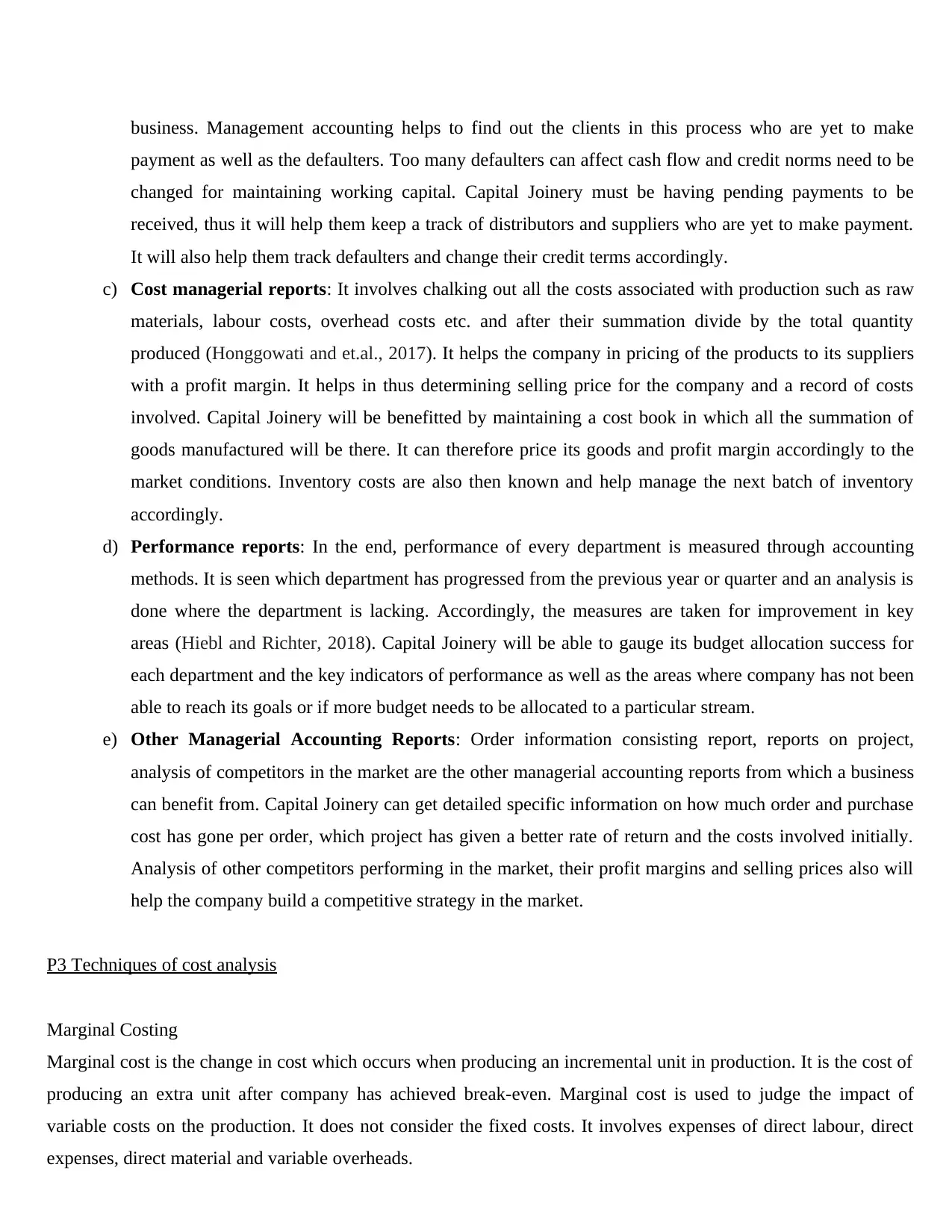
business. Management accounting helps to find out the clients in this process who are yet to make
payment as well as the defaulters. Too many defaulters can affect cash flow and credit norms need to be
changed for maintaining working capital. Capital Joinery must be having pending payments to be
received, thus it will help them keep a track of distributors and suppliers who are yet to make payment.
It will also help them track defaulters and change their credit terms accordingly.
c) Cost managerial reports: It involves chalking out all the costs associated with production such as raw
materials, labour costs, overhead costs etc. and after their summation divide by the total quantity
produced (Honggowati and et.al., 2017). It helps the company in pricing of the products to its suppliers
with a profit margin. It helps in thus determining selling price for the company and a record of costs
involved. Capital Joinery will be benefitted by maintaining a cost book in which all the summation of
goods manufactured will be there. It can therefore price its goods and profit margin accordingly to the
market conditions. Inventory costs are also then known and help manage the next batch of inventory
accordingly.
d) Performance reports: In the end, performance of every department is measured through accounting
methods. It is seen which department has progressed from the previous year or quarter and an analysis is
done where the department is lacking. Accordingly, the measures are taken for improvement in key
areas (Hiebl and Richter, 2018). Capital Joinery will be able to gauge its budget allocation success for
each department and the key indicators of performance as well as the areas where company has not been
able to reach its goals or if more budget needs to be allocated to a particular stream.
e) Other Managerial Accounting Reports: Order information consisting report, reports on project,
analysis of competitors in the market are the other managerial accounting reports from which a business
can benefit from. Capital Joinery can get detailed specific information on how much order and purchase
cost has gone per order, which project has given a better rate of return and the costs involved initially.
Analysis of other competitors performing in the market, their profit margins and selling prices also will
help the company build a competitive strategy in the market.
P3 Techniques of cost analysis
Marginal Costing
Marginal cost is the change in cost which occurs when producing an incremental unit in production. It is the cost of
producing an extra unit after company has achieved break-even. Marginal cost is used to judge the impact of
variable costs on the production. It does not consider the fixed costs. It involves expenses of direct labour, direct
expenses, direct material and variable overheads.
payment as well as the defaulters. Too many defaulters can affect cash flow and credit norms need to be
changed for maintaining working capital. Capital Joinery must be having pending payments to be
received, thus it will help them keep a track of distributors and suppliers who are yet to make payment.
It will also help them track defaulters and change their credit terms accordingly.
c) Cost managerial reports: It involves chalking out all the costs associated with production such as raw
materials, labour costs, overhead costs etc. and after their summation divide by the total quantity
produced (Honggowati and et.al., 2017). It helps the company in pricing of the products to its suppliers
with a profit margin. It helps in thus determining selling price for the company and a record of costs
involved. Capital Joinery will be benefitted by maintaining a cost book in which all the summation of
goods manufactured will be there. It can therefore price its goods and profit margin accordingly to the
market conditions. Inventory costs are also then known and help manage the next batch of inventory
accordingly.
d) Performance reports: In the end, performance of every department is measured through accounting
methods. It is seen which department has progressed from the previous year or quarter and an analysis is
done where the department is lacking. Accordingly, the measures are taken for improvement in key
areas (Hiebl and Richter, 2018). Capital Joinery will be able to gauge its budget allocation success for
each department and the key indicators of performance as well as the areas where company has not been
able to reach its goals or if more budget needs to be allocated to a particular stream.
e) Other Managerial Accounting Reports: Order information consisting report, reports on project,
analysis of competitors in the market are the other managerial accounting reports from which a business
can benefit from. Capital Joinery can get detailed specific information on how much order and purchase
cost has gone per order, which project has given a better rate of return and the costs involved initially.
Analysis of other competitors performing in the market, their profit margins and selling prices also will
help the company build a competitive strategy in the market.
P3 Techniques of cost analysis
Marginal Costing
Marginal cost is the change in cost which occurs when producing an incremental unit in production. It is the cost of
producing an extra unit after company has achieved break-even. Marginal cost is used to judge the impact of
variable costs on the production. It does not consider the fixed costs. It involves expenses of direct labour, direct
expenses, direct material and variable overheads.
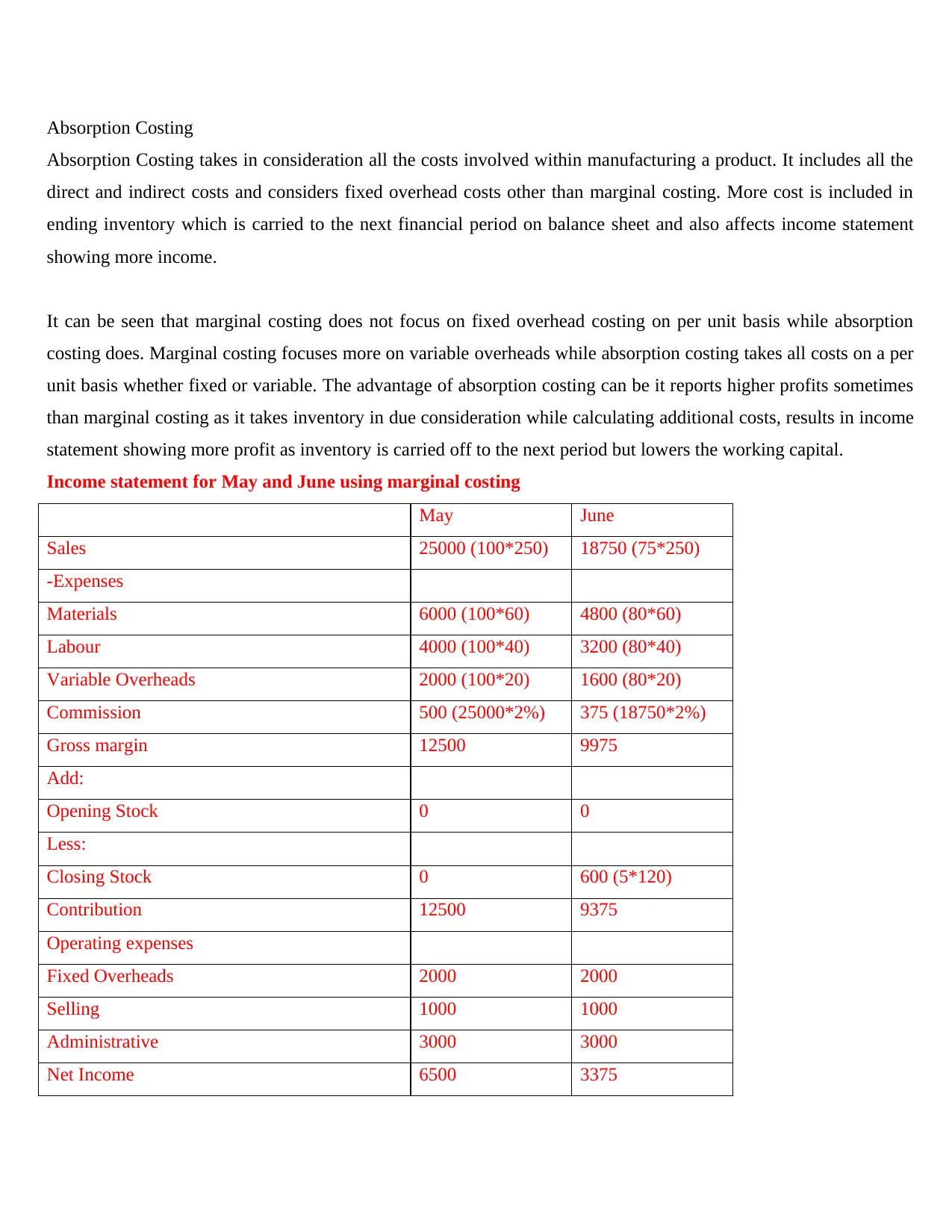
Absorption Costing
Absorption Costing takes in consideration all the costs involved within manufacturing a product. It includes all the
direct and indirect costs and considers fixed overhead costs other than marginal costing. More cost is included in
ending inventory which is carried to the next financial period on balance sheet and also affects income statement
showing more income.
It can be seen that marginal costing does not focus on fixed overhead costing on per unit basis while absorption
costing does. Marginal costing focuses more on variable overheads while absorption costing takes all costs on a per
unit basis whether fixed or variable. The advantage of absorption costing can be it reports higher profits sometimes
than marginal costing as it takes inventory in due consideration while calculating additional costs, results in income
statement showing more profit as inventory is carried off to the next period but lowers the working capital.
Income statement for May and June using marginal costing
May June
Sales 25000 (100*250) 18750 (75*250)
-Expenses
Materials 6000 (100*60) 4800 (80*60)
Labour 4000 (100*40) 3200 (80*40)
Variable Overheads 2000 (100*20) 1600 (80*20)
Commission 500 (25000*2%) 375 (18750*2%)
Gross margin 12500 9975
Add:
Opening Stock 0 0
Less:
Closing Stock 0 600 (5*120)
Contribution 12500 9375
Operating expenses
Fixed Overheads 2000 2000
Selling 1000 1000
Administrative 3000 3000
Net Income 6500 3375
Absorption Costing takes in consideration all the costs involved within manufacturing a product. It includes all the
direct and indirect costs and considers fixed overhead costs other than marginal costing. More cost is included in
ending inventory which is carried to the next financial period on balance sheet and also affects income statement
showing more income.
It can be seen that marginal costing does not focus on fixed overhead costing on per unit basis while absorption
costing does. Marginal costing focuses more on variable overheads while absorption costing takes all costs on a per
unit basis whether fixed or variable. The advantage of absorption costing can be it reports higher profits sometimes
than marginal costing as it takes inventory in due consideration while calculating additional costs, results in income
statement showing more profit as inventory is carried off to the next period but lowers the working capital.
Income statement for May and June using marginal costing
May June
Sales 25000 (100*250) 18750 (75*250)
-Expenses
Materials 6000 (100*60) 4800 (80*60)
Labour 4000 (100*40) 3200 (80*40)
Variable Overheads 2000 (100*20) 1600 (80*20)
Commission 500 (25000*2%) 375 (18750*2%)
Gross margin 12500 9975
Add:
Opening Stock 0 0
Less:
Closing Stock 0 600 (5*120)
Contribution 12500 9375
Operating expenses
Fixed Overheads 2000 2000
Selling 1000 1000
Administrative 3000 3000
Net Income 6500 3375
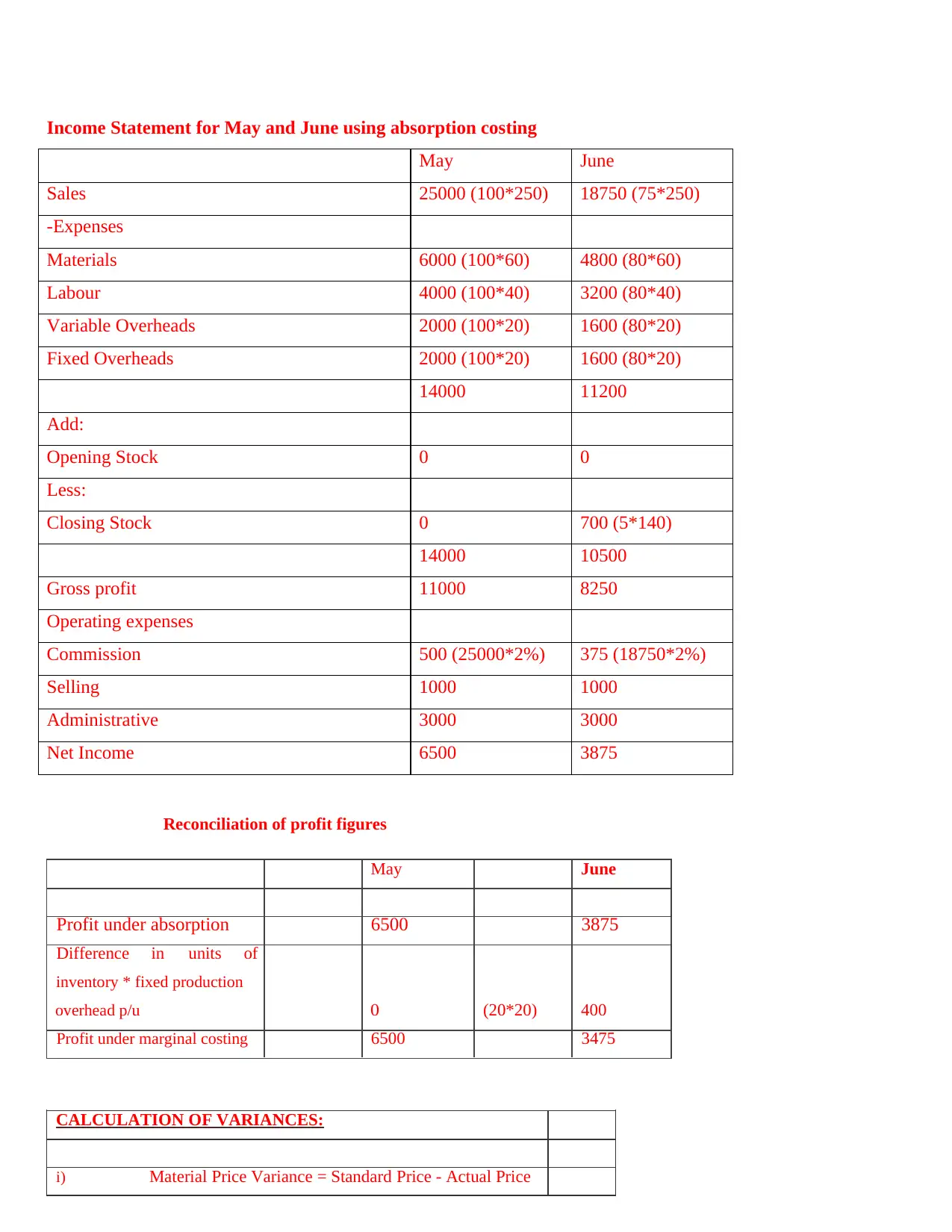
Income Statement for May and June using absorption costing
May June
Sales 25000 (100*250) 18750 (75*250)
-Expenses
Materials 6000 (100*60) 4800 (80*60)
Labour 4000 (100*40) 3200 (80*40)
Variable Overheads 2000 (100*20) 1600 (80*20)
Fixed Overheads 2000 (100*20) 1600 (80*20)
14000 11200
Add:
Opening Stock 0 0
Less:
Closing Stock 0 700 (5*140)
14000 10500
Gross profit 11000 8250
Operating expenses
Commission 500 (25000*2%) 375 (18750*2%)
Selling 1000 1000
Administrative 3000 3000
Net Income 6500 3875
Reconciliation of profit figures
May June
Profit under absorption 6500 3875
Difference in units of
inventory * fixed production
overhead p/u 0 (20*20) 400
Profit under marginal costing 6500 3475
CALCULATION OF VARIANCES:
i) Material Price Variance = Standard Price - Actual Price
May June
Sales 25000 (100*250) 18750 (75*250)
-Expenses
Materials 6000 (100*60) 4800 (80*60)
Labour 4000 (100*40) 3200 (80*40)
Variable Overheads 2000 (100*20) 1600 (80*20)
Fixed Overheads 2000 (100*20) 1600 (80*20)
14000 11200
Add:
Opening Stock 0 0
Less:
Closing Stock 0 700 (5*140)
14000 10500
Gross profit 11000 8250
Operating expenses
Commission 500 (25000*2%) 375 (18750*2%)
Selling 1000 1000
Administrative 3000 3000
Net Income 6500 3875
Reconciliation of profit figures
May June
Profit under absorption 6500 3875
Difference in units of
inventory * fixed production
overhead p/u 0 (20*20) 400
Profit under marginal costing 6500 3475
CALCULATION OF VARIANCES:
i) Material Price Variance = Standard Price - Actual Price
Paraphrase This Document
Need a fresh take? Get an instant paraphrase of this document with our AI Paraphraser
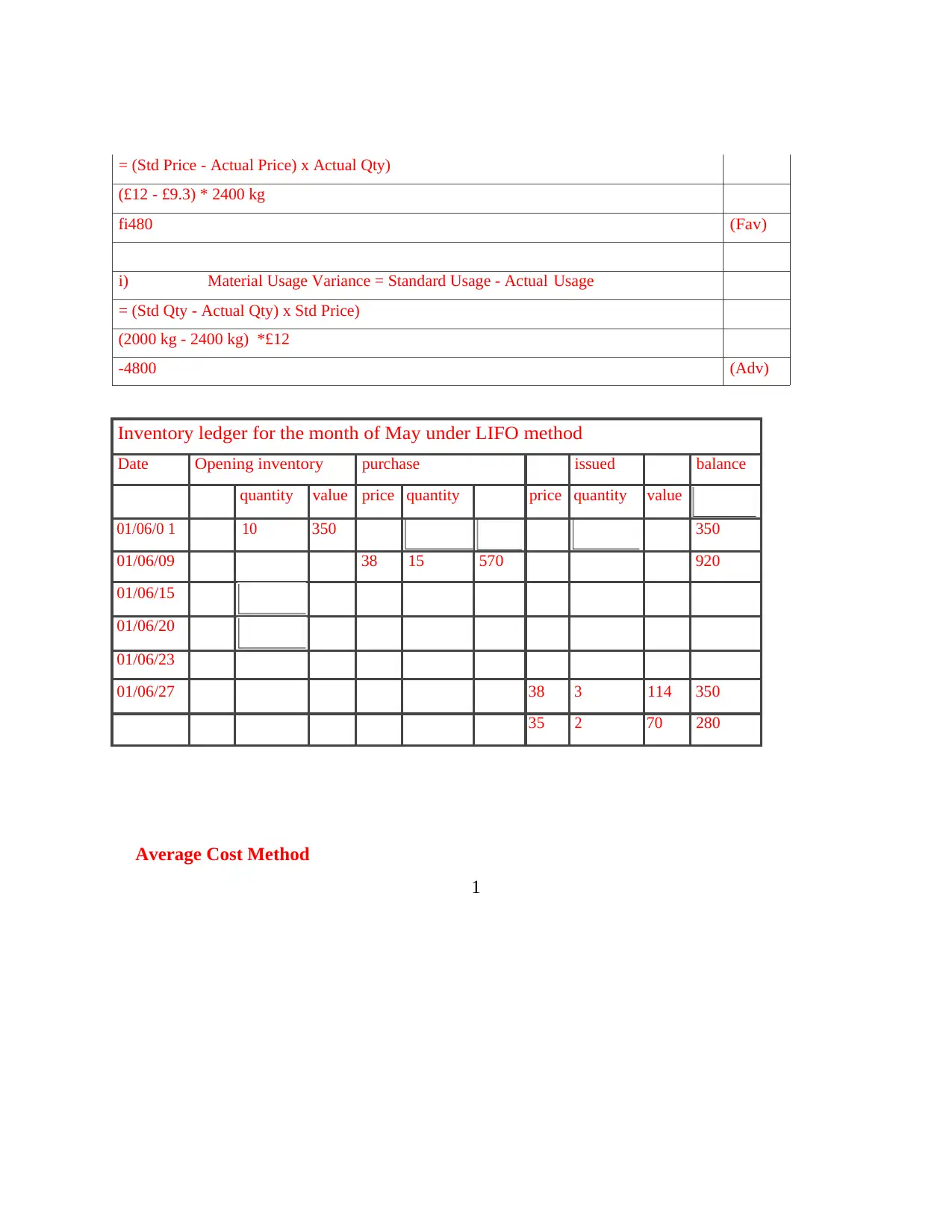
= (Std Price - Actual Price) x Actual Qty)
(£12 - £9.3) * 2400 kg
fi480 (Fav)
i) Material Usage Variance = Standard Usage - Actual Usage
= (Std Qty - Actual Qty) x Std Price)
(2000 kg - 2400 kg) *£12
-4800 (Adv)
Inventory ledger for the month of May under LIFO method
Date Opening inventory purchase issued balance
quantity value price quantity price quantity value
01/06/0 1 10 350 350
01/06/09 38 15 570 920
01/06/15
01/06/20
01/06/23
01/06/27 38 3 114 350
35 2 70 280
Average Cost Method
1
(£12 - £9.3) * 2400 kg
fi480 (Fav)
i) Material Usage Variance = Standard Usage - Actual Usage
= (Std Qty - Actual Qty) x Std Price)
(2000 kg - 2400 kg) *£12
-4800 (Adv)
Inventory ledger for the month of May under LIFO method
Date Opening inventory purchase issued balance
quantity value price quantity price quantity value
01/06/0 1 10 350 350
01/06/09 38 15 570 920
01/06/15
01/06/20
01/06/23
01/06/27 38 3 114 350
35 2 70 280
Average Cost Method
1
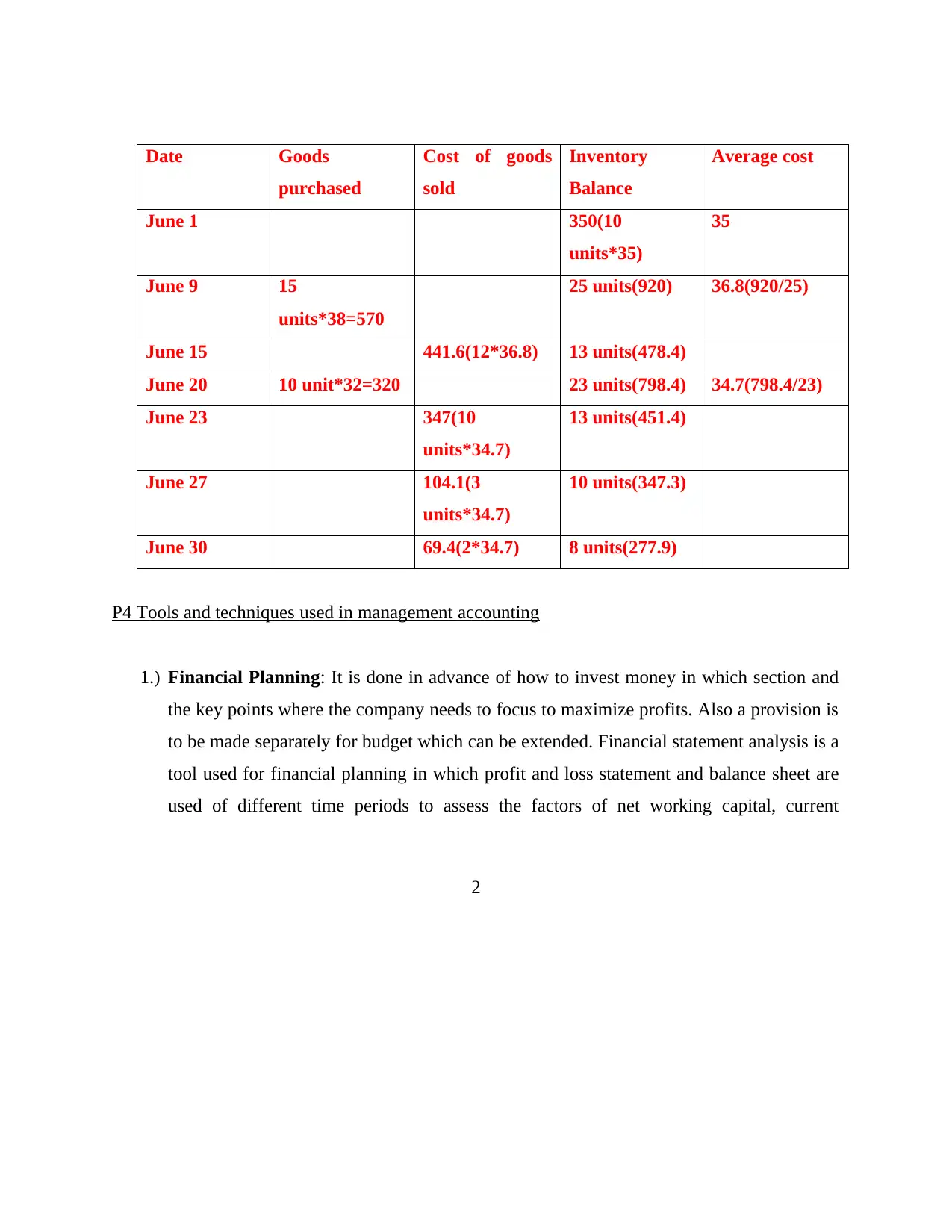
Date Goods
purchased
Cost of goods
sold
Inventory
Balance
Average cost
June 1 350(10
units*35)
35
June 9 15
units*38=570
25 units(920) 36.8(920/25)
June 15 441.6(12*36.8) 13 units(478.4)
June 20 10 unit*32=320 23 units(798.4) 34.7(798.4/23)
June 23 347(10
units*34.7)
13 units(451.4)
June 27 104.1(3
units*34.7)
10 units(347.3)
June 30 69.4(2*34.7) 8 units(277.9)
P4 Tools and techniques used in management accounting
1.) Financial Planning: It is done in advance of how to invest money in which section and
the key points where the company needs to focus to maximize profits. Also a provision is
to be made separately for budget which can be extended. Financial statement analysis is a
tool used for financial planning in which profit and loss statement and balance sheet are
used of different time periods to assess the factors of net working capital, current
2
purchased
Cost of goods
sold
Inventory
Balance
Average cost
June 1 350(10
units*35)
35
June 9 15
units*38=570
25 units(920) 36.8(920/25)
June 15 441.6(12*36.8) 13 units(478.4)
June 20 10 unit*32=320 23 units(798.4) 34.7(798.4/23)
June 23 347(10
units*34.7)
13 units(451.4)
June 27 104.1(3
units*34.7)
10 units(347.3)
June 30 69.4(2*34.7) 8 units(277.9)
P4 Tools and techniques used in management accounting
1.) Financial Planning: It is done in advance of how to invest money in which section and
the key points where the company needs to focus to maximize profits. Also a provision is
to be made separately for budget which can be extended. Financial statement analysis is a
tool used for financial planning in which profit and loss statement and balance sheet are
used of different time periods to assess the factors of net working capital, current
2
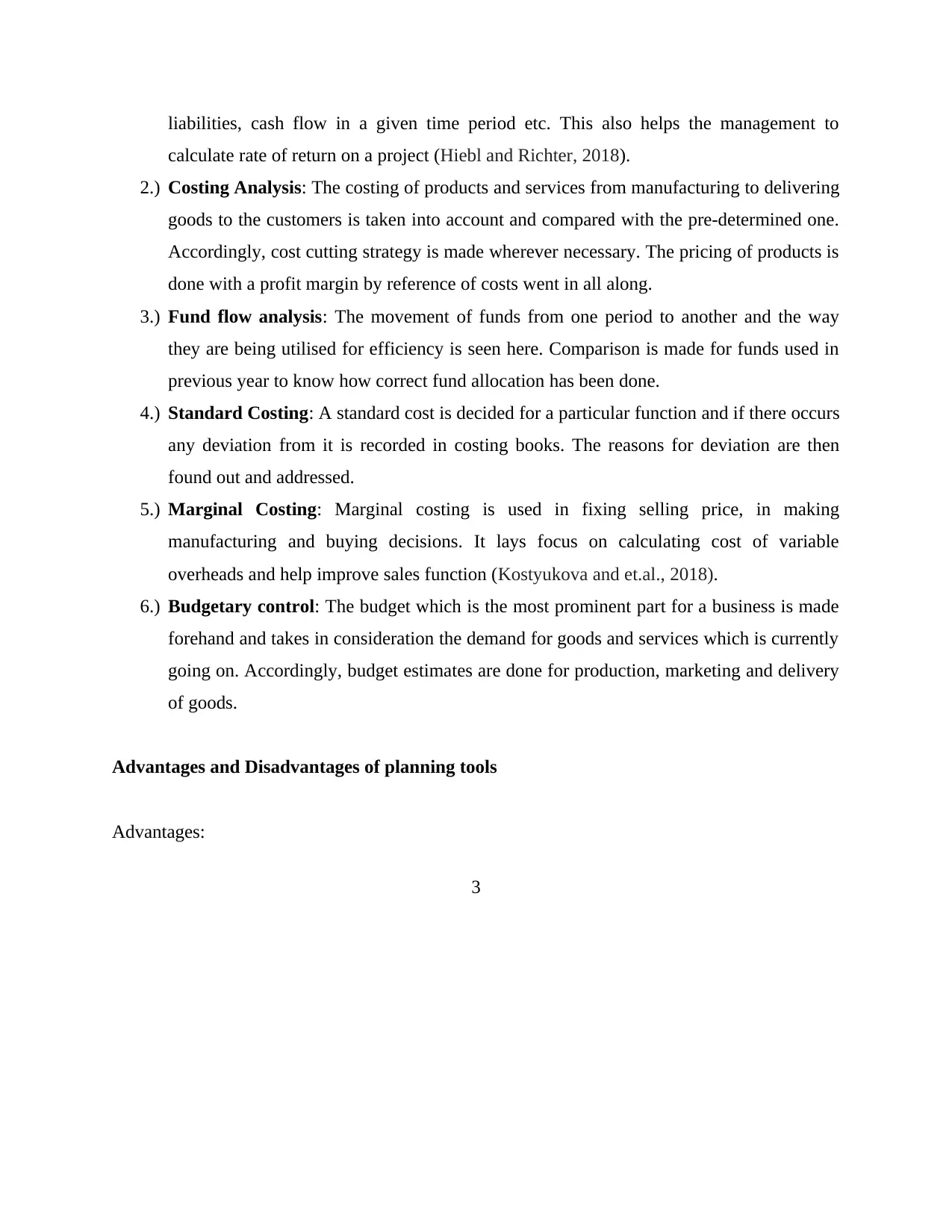
liabilities, cash flow in a given time period etc. This also helps the management to
calculate rate of return on a project (Hiebl and Richter, 2018).
2.) Costing Analysis: The costing of products and services from manufacturing to delivering
goods to the customers is taken into account and compared with the pre-determined one.
Accordingly, cost cutting strategy is made wherever necessary. The pricing of products is
done with a profit margin by reference of costs went in all along.
3.) Fund flow analysis: The movement of funds from one period to another and the way
they are being utilised for efficiency is seen here. Comparison is made for funds used in
previous year to know how correct fund allocation has been done.
4.) Standard Costing: A standard cost is decided for a particular function and if there occurs
any deviation from it is recorded in costing books. The reasons for deviation are then
found out and addressed.
5.) Marginal Costing: Marginal costing is used in fixing selling price, in making
manufacturing and buying decisions. It lays focus on calculating cost of variable
overheads and help improve sales function (Kostyukova and et.al., 2018).
6.) Budgetary control: The budget which is the most prominent part for a business is made
forehand and takes in consideration the demand for goods and services which is currently
going on. Accordingly, budget estimates are done for production, marketing and delivery
of goods.
Advantages and Disadvantages of planning tools
Advantages:
3
calculate rate of return on a project (Hiebl and Richter, 2018).
2.) Costing Analysis: The costing of products and services from manufacturing to delivering
goods to the customers is taken into account and compared with the pre-determined one.
Accordingly, cost cutting strategy is made wherever necessary. The pricing of products is
done with a profit margin by reference of costs went in all along.
3.) Fund flow analysis: The movement of funds from one period to another and the way
they are being utilised for efficiency is seen here. Comparison is made for funds used in
previous year to know how correct fund allocation has been done.
4.) Standard Costing: A standard cost is decided for a particular function and if there occurs
any deviation from it is recorded in costing books. The reasons for deviation are then
found out and addressed.
5.) Marginal Costing: Marginal costing is used in fixing selling price, in making
manufacturing and buying decisions. It lays focus on calculating cost of variable
overheads and help improve sales function (Kostyukova and et.al., 2018).
6.) Budgetary control: The budget which is the most prominent part for a business is made
forehand and takes in consideration the demand for goods and services which is currently
going on. Accordingly, budget estimates are done for production, marketing and delivery
of goods.
Advantages and Disadvantages of planning tools
Advantages:
3
Secure Best Marks with AI Grader
Need help grading? Try our AI Grader for instant feedback on your assignments.
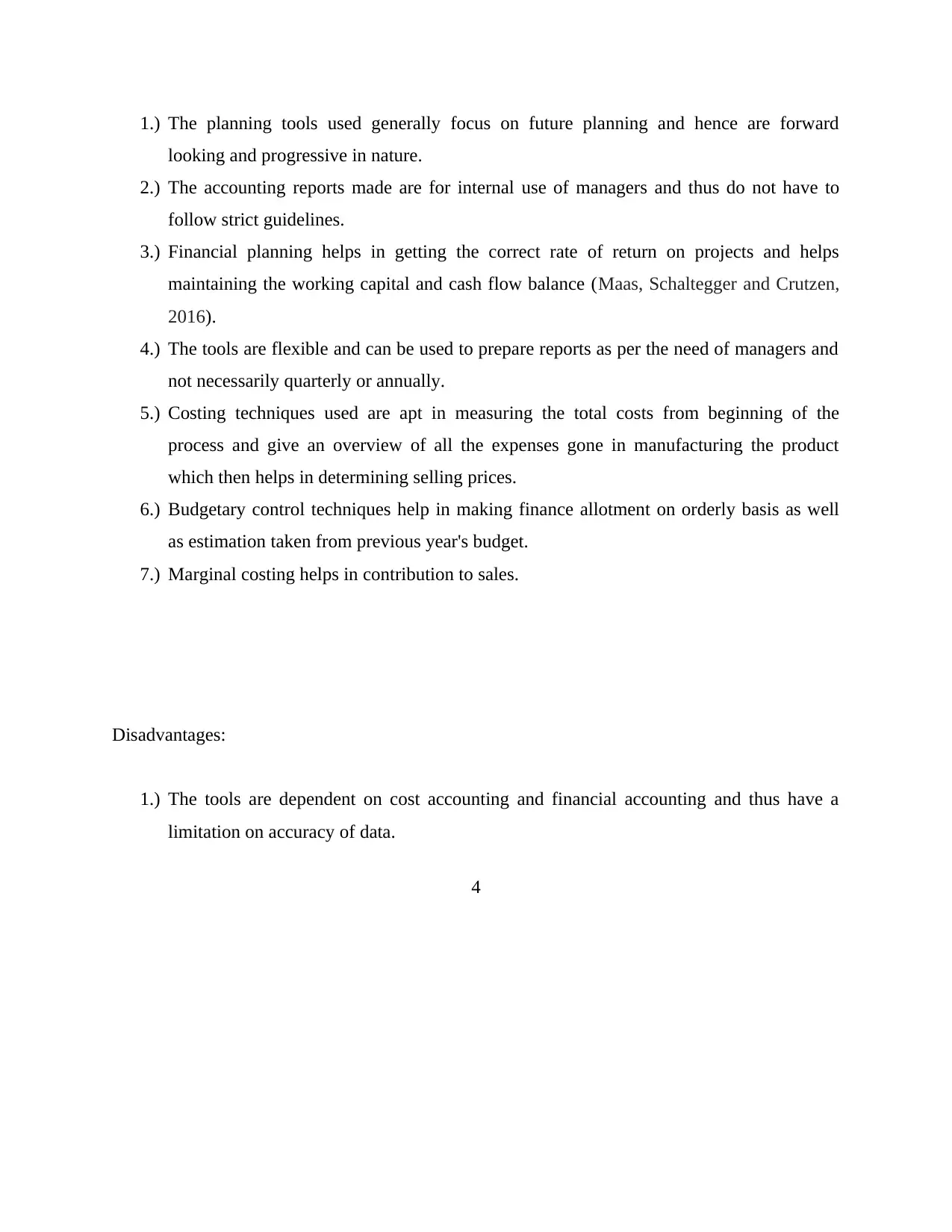
1.) The planning tools used generally focus on future planning and hence are forward
looking and progressive in nature.
2.) The accounting reports made are for internal use of managers and thus do not have to
follow strict guidelines.
3.) Financial planning helps in getting the correct rate of return on projects and helps
maintaining the working capital and cash flow balance (Maas, Schaltegger and Crutzen,
2016).
4.) The tools are flexible and can be used to prepare reports as per the need of managers and
not necessarily quarterly or annually.
5.) Costing techniques used are apt in measuring the total costs from beginning of the
process and give an overview of all the expenses gone in manufacturing the product
which then helps in determining selling prices.
6.) Budgetary control techniques help in making finance allotment on orderly basis as well
as estimation taken from previous year's budget.
7.) Marginal costing helps in contribution to sales.
Disadvantages:
1.) The tools are dependent on cost accounting and financial accounting and thus have a
limitation on accuracy of data.
4
looking and progressive in nature.
2.) The accounting reports made are for internal use of managers and thus do not have to
follow strict guidelines.
3.) Financial planning helps in getting the correct rate of return on projects and helps
maintaining the working capital and cash flow balance (Maas, Schaltegger and Crutzen,
2016).
4.) The tools are flexible and can be used to prepare reports as per the need of managers and
not necessarily quarterly or annually.
5.) Costing techniques used are apt in measuring the total costs from beginning of the
process and give an overview of all the expenses gone in manufacturing the product
which then helps in determining selling prices.
6.) Budgetary control techniques help in making finance allotment on orderly basis as well
as estimation taken from previous year's budget.
7.) Marginal costing helps in contribution to sales.
Disadvantages:
1.) The tools are dependent on cost accounting and financial accounting and thus have a
limitation on accuracy of data.
4

2.) Top management can bias in making these reports as to have more influence on the
company's operations.
3.) The flexibility of not using strict accounting principles limits a company reports
comparison with another company.
4.) As it focuses on future planning, errors can occur in financial allotment which may lead
to a loss as estimations are not always correct.
5.) In determining selling price, other factors than costing like market competition have to be
also considered which is not covered in management accounting's scope.
P5 Comparison of companies responding to financial problems using management accounting
Tesco and Sainsbury are retail giants in grocery and merchandise. Both companies have used
management accounting to their benefits which have helped them in financial matters. A
comparison of them using management accounting techniques for their benefits is as follows:
Factors Tesco Sainsbury
Financial Planning Tesco from early on has been
using financial data to plan
accordingly for its investments
in product merchandise, use of
technology and its suppliers'
commission in the market.
This has helped to allocate
Sainsbury has financially
planned well with
management accounting and
has been able to delegate
funds to its stores as per their
demand and purchases in the
previous period of grocery and
5
company's operations.
3.) The flexibility of not using strict accounting principles limits a company reports
comparison with another company.
4.) As it focuses on future planning, errors can occur in financial allotment which may lead
to a loss as estimations are not always correct.
5.) In determining selling price, other factors than costing like market competition have to be
also considered which is not covered in management accounting's scope.
P5 Comparison of companies responding to financial problems using management accounting
Tesco and Sainsbury are retail giants in grocery and merchandise. Both companies have used
management accounting to their benefits which have helped them in financial matters. A
comparison of them using management accounting techniques for their benefits is as follows:
Factors Tesco Sainsbury
Financial Planning Tesco from early on has been
using financial data to plan
accordingly for its investments
in product merchandise, use of
technology and its suppliers'
commission in the market.
This has helped to allocate
Sainsbury has financially
planned well with
management accounting and
has been able to delegate
funds to its stores as per their
demand and purchases in the
previous period of grocery and
5

finance to every section with a
provision separately. In
general merchandise, they
continue to focus budget on
sustainable categories like Fox
and Ivy and Go Cook ranges.
food related products.
Sainsbury. Sainsbury has
financing facilities of around
euro 3.9 billion which are
from diverse funding sources
to minimize refinancing risks.
Costing Analysis Tesco uses costing techniques
to calculate its overall cost of
production along with fixed
and variable costs. This has
helped the company in
developing a profit margin and
selling price determination of
the products. Also, these costs
are also used for future
purposes to know where they
have to do cost cutting such as
inventory storage etc. Tesco
also states that they have
maintained their pricing
strategy in lieu of customer
feedback. Tesco had decided
to slash the costs by euro 1.5
Sainsbury has used costing to
keep its products at a low
price with cost cutting
measures as variable costs get
known to it by costing and it is
easy for management to do
cost reduction there. It also
thus has a positive impact on
revenues (Kostyukova and
et.al., 2018). Sainsbury had
achieved euro 130 million of
cost savings 2 years back and
have an aim of euro 500
million cost savings till 2021-
22.
6
provision separately. In
general merchandise, they
continue to focus budget on
sustainable categories like Fox
and Ivy and Go Cook ranges.
food related products.
Sainsbury. Sainsbury has
financing facilities of around
euro 3.9 billion which are
from diverse funding sources
to minimize refinancing risks.
Costing Analysis Tesco uses costing techniques
to calculate its overall cost of
production along with fixed
and variable costs. This has
helped the company in
developing a profit margin and
selling price determination of
the products. Also, these costs
are also used for future
purposes to know where they
have to do cost cutting such as
inventory storage etc. Tesco
also states that they have
maintained their pricing
strategy in lieu of customer
feedback. Tesco had decided
to slash the costs by euro 1.5
Sainsbury has used costing to
keep its products at a low
price with cost cutting
measures as variable costs get
known to it by costing and it is
easy for management to do
cost reduction there. It also
thus has a positive impact on
revenues (Kostyukova and
et.al., 2018). Sainsbury had
achieved euro 130 million of
cost savings 2 years back and
have an aim of euro 500
million cost savings till 2021-
22.
6
Paraphrase This Document
Need a fresh take? Get an instant paraphrase of this document with our AI Paraphraser
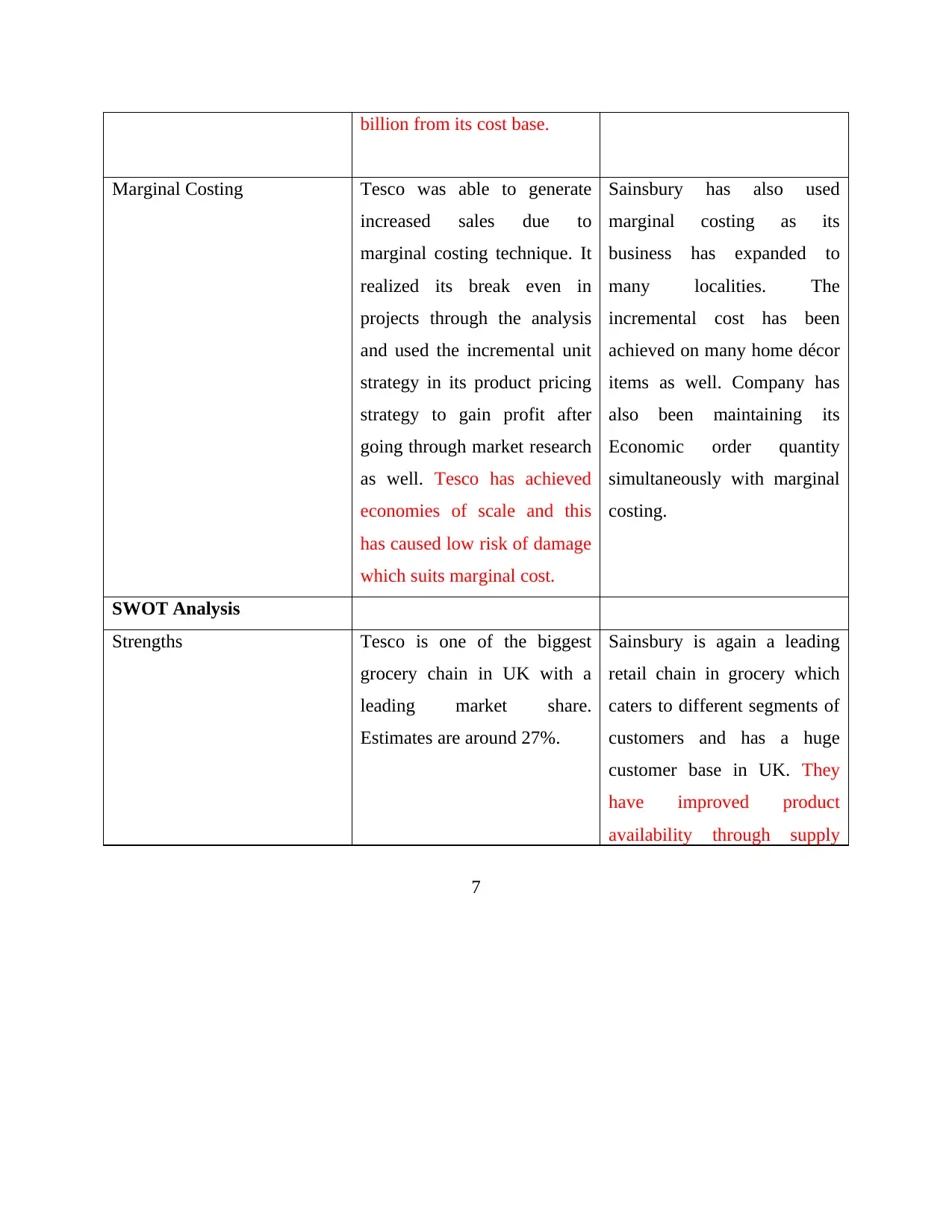
billion from its cost base.
Marginal Costing Tesco was able to generate
increased sales due to
marginal costing technique. It
realized its break even in
projects through the analysis
and used the incremental unit
strategy in its product pricing
strategy to gain profit after
going through market research
as well. Tesco has achieved
economies of scale and this
has caused low risk of damage
which suits marginal cost.
Sainsbury has also used
marginal costing as its
business has expanded to
many localities. The
incremental cost has been
achieved on many home décor
items as well. Company has
also been maintaining its
Economic order quantity
simultaneously with marginal
costing.
SWOT Analysis
Strengths Tesco is one of the biggest
grocery chain in UK with a
leading market share.
Estimates are around 27%.
Sainsbury is again a leading
retail chain in grocery which
caters to different segments of
customers and has a huge
customer base in UK. They
have improved product
availability through supply
7
Marginal Costing Tesco was able to generate
increased sales due to
marginal costing technique. It
realized its break even in
projects through the analysis
and used the incremental unit
strategy in its product pricing
strategy to gain profit after
going through market research
as well. Tesco has achieved
economies of scale and this
has caused low risk of damage
which suits marginal cost.
Sainsbury has also used
marginal costing as its
business has expanded to
many localities. The
incremental cost has been
achieved on many home décor
items as well. Company has
also been maintaining its
Economic order quantity
simultaneously with marginal
costing.
SWOT Analysis
Strengths Tesco is one of the biggest
grocery chain in UK with a
leading market share.
Estimates are around 27%.
Sainsbury is again a leading
retail chain in grocery which
caters to different segments of
customers and has a huge
customer base in UK. They
have improved product
availability through supply
7
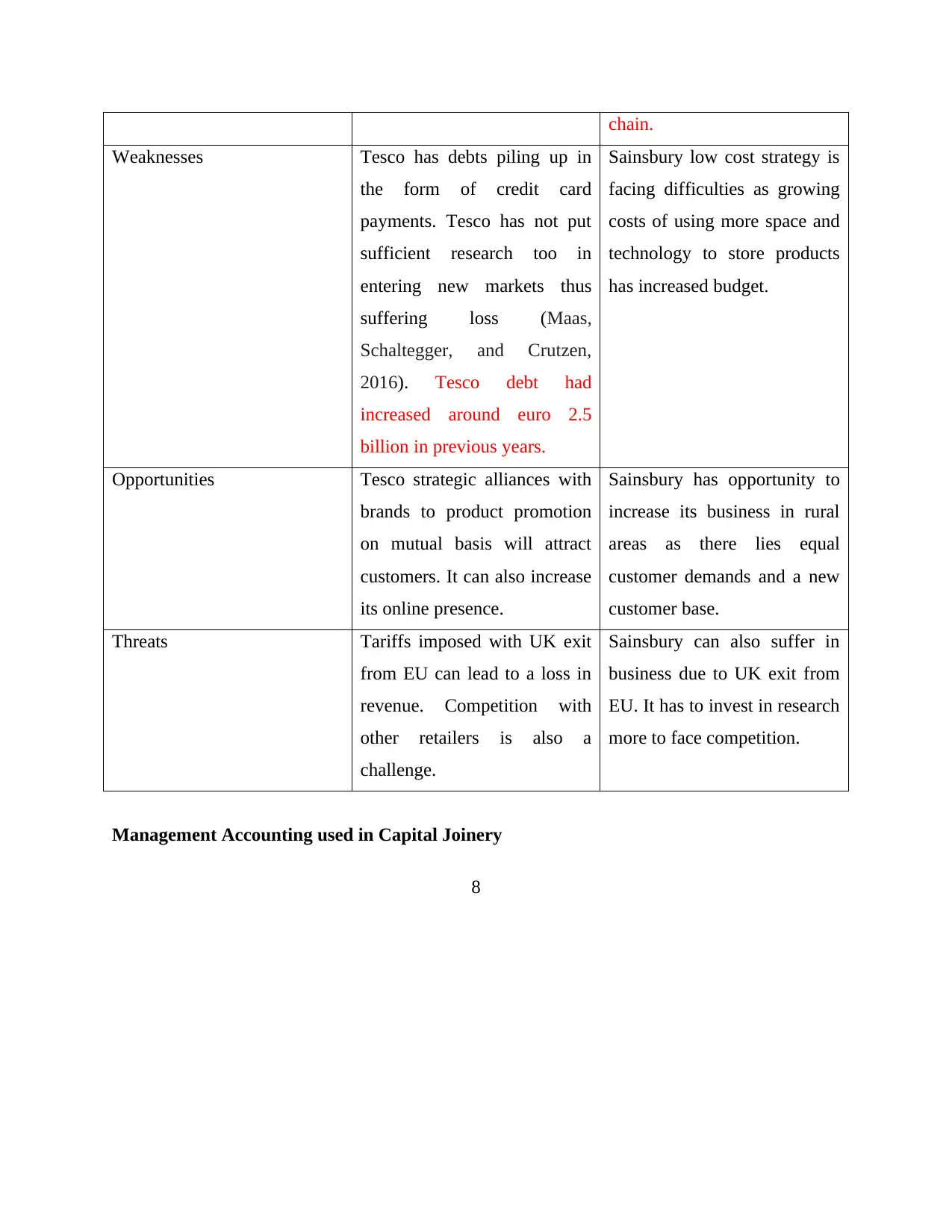
chain.
Weaknesses Tesco has debts piling up in
the form of credit card
payments. Tesco has not put
sufficient research too in
entering new markets thus
suffering loss (Maas,
Schaltegger, and Crutzen,
2016). Tesco debt had
increased around euro 2.5
billion in previous years.
Sainsbury low cost strategy is
facing difficulties as growing
costs of using more space and
technology to store products
has increased budget.
Opportunities Tesco strategic alliances with
brands to product promotion
on mutual basis will attract
customers. It can also increase
its online presence.
Sainsbury has opportunity to
increase its business in rural
areas as there lies equal
customer demands and a new
customer base.
Threats Tariffs imposed with UK exit
from EU can lead to a loss in
revenue. Competition with
other retailers is also a
challenge.
Sainsbury can also suffer in
business due to UK exit from
EU. It has to invest in research
more to face competition.
Management Accounting used in Capital Joinery
8
Weaknesses Tesco has debts piling up in
the form of credit card
payments. Tesco has not put
sufficient research too in
entering new markets thus
suffering loss (Maas,
Schaltegger, and Crutzen,
2016). Tesco debt had
increased around euro 2.5
billion in previous years.
Sainsbury low cost strategy is
facing difficulties as growing
costs of using more space and
technology to store products
has increased budget.
Opportunities Tesco strategic alliances with
brands to product promotion
on mutual basis will attract
customers. It can also increase
its online presence.
Sainsbury has opportunity to
increase its business in rural
areas as there lies equal
customer demands and a new
customer base.
Threats Tariffs imposed with UK exit
from EU can lead to a loss in
revenue. Competition with
other retailers is also a
challenge.
Sainsbury can also suffer in
business due to UK exit from
EU. It has to invest in research
more to face competition.
Management Accounting used in Capital Joinery
8
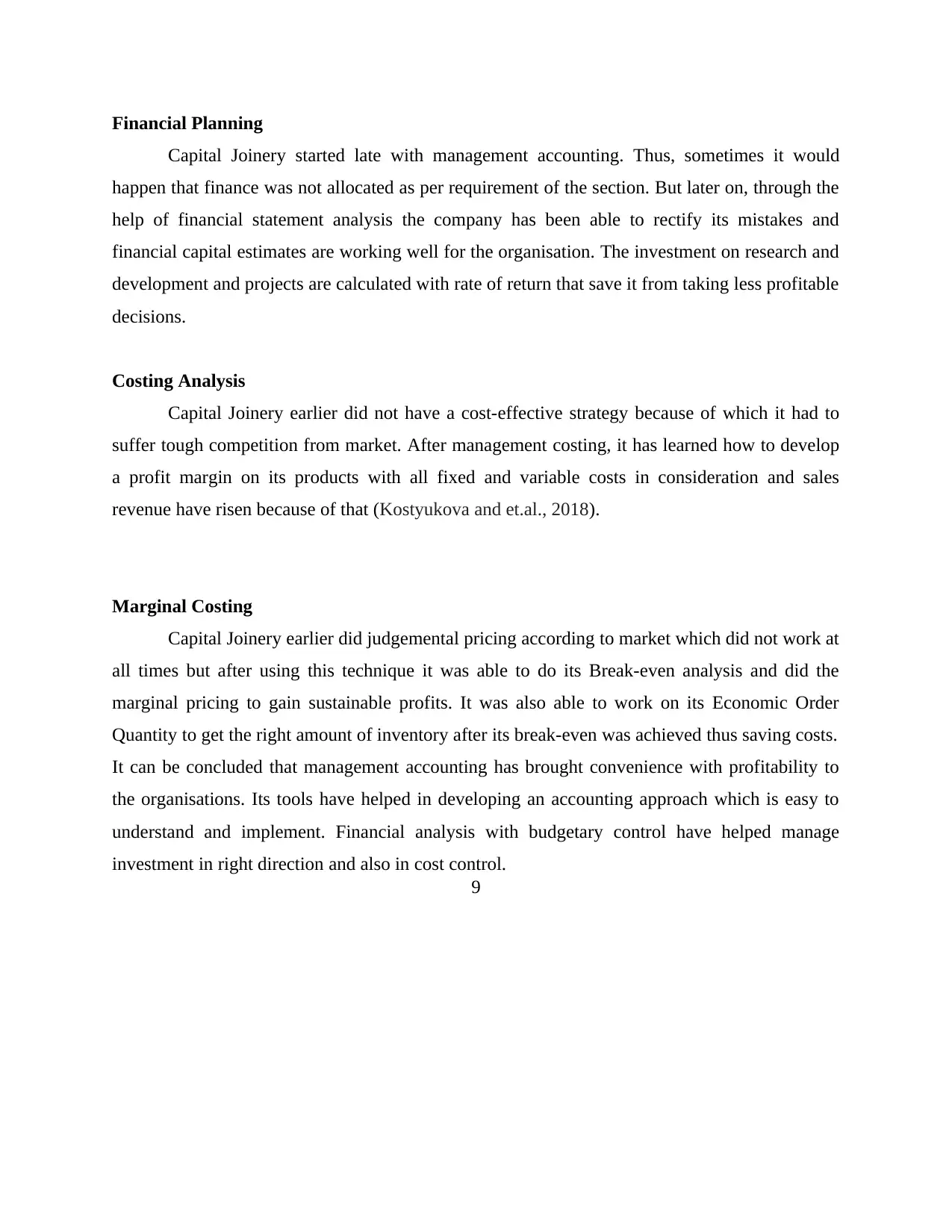
Financial Planning
Capital Joinery started late with management accounting. Thus, sometimes it would
happen that finance was not allocated as per requirement of the section. But later on, through the
help of financial statement analysis the company has been able to rectify its mistakes and
financial capital estimates are working well for the organisation. The investment on research and
development and projects are calculated with rate of return that save it from taking less profitable
decisions.
Costing Analysis
Capital Joinery earlier did not have a cost-effective strategy because of which it had to
suffer tough competition from market. After management costing, it has learned how to develop
a profit margin on its products with all fixed and variable costs in consideration and sales
revenue have risen because of that (Kostyukova and et.al., 2018).
Marginal Costing
Capital Joinery earlier did judgemental pricing according to market which did not work at
all times but after using this technique it was able to do its Break-even analysis and did the
marginal pricing to gain sustainable profits. It was also able to work on its Economic Order
Quantity to get the right amount of inventory after its break-even was achieved thus saving costs.
It can be concluded that management accounting has brought convenience with profitability to
the organisations. Its tools have helped in developing an accounting approach which is easy to
understand and implement. Financial analysis with budgetary control have helped manage
investment in right direction and also in cost control.
9
Capital Joinery started late with management accounting. Thus, sometimes it would
happen that finance was not allocated as per requirement of the section. But later on, through the
help of financial statement analysis the company has been able to rectify its mistakes and
financial capital estimates are working well for the organisation. The investment on research and
development and projects are calculated with rate of return that save it from taking less profitable
decisions.
Costing Analysis
Capital Joinery earlier did not have a cost-effective strategy because of which it had to
suffer tough competition from market. After management costing, it has learned how to develop
a profit margin on its products with all fixed and variable costs in consideration and sales
revenue have risen because of that (Kostyukova and et.al., 2018).
Marginal Costing
Capital Joinery earlier did judgemental pricing according to market which did not work at
all times but after using this technique it was able to do its Break-even analysis and did the
marginal pricing to gain sustainable profits. It was also able to work on its Economic Order
Quantity to get the right amount of inventory after its break-even was achieved thus saving costs.
It can be concluded that management accounting has brought convenience with profitability to
the organisations. Its tools have helped in developing an accounting approach which is easy to
understand and implement. Financial analysis with budgetary control have helped manage
investment in right direction and also in cost control.
9
Secure Best Marks with AI Grader
Need help grading? Try our AI Grader for instant feedback on your assignments.
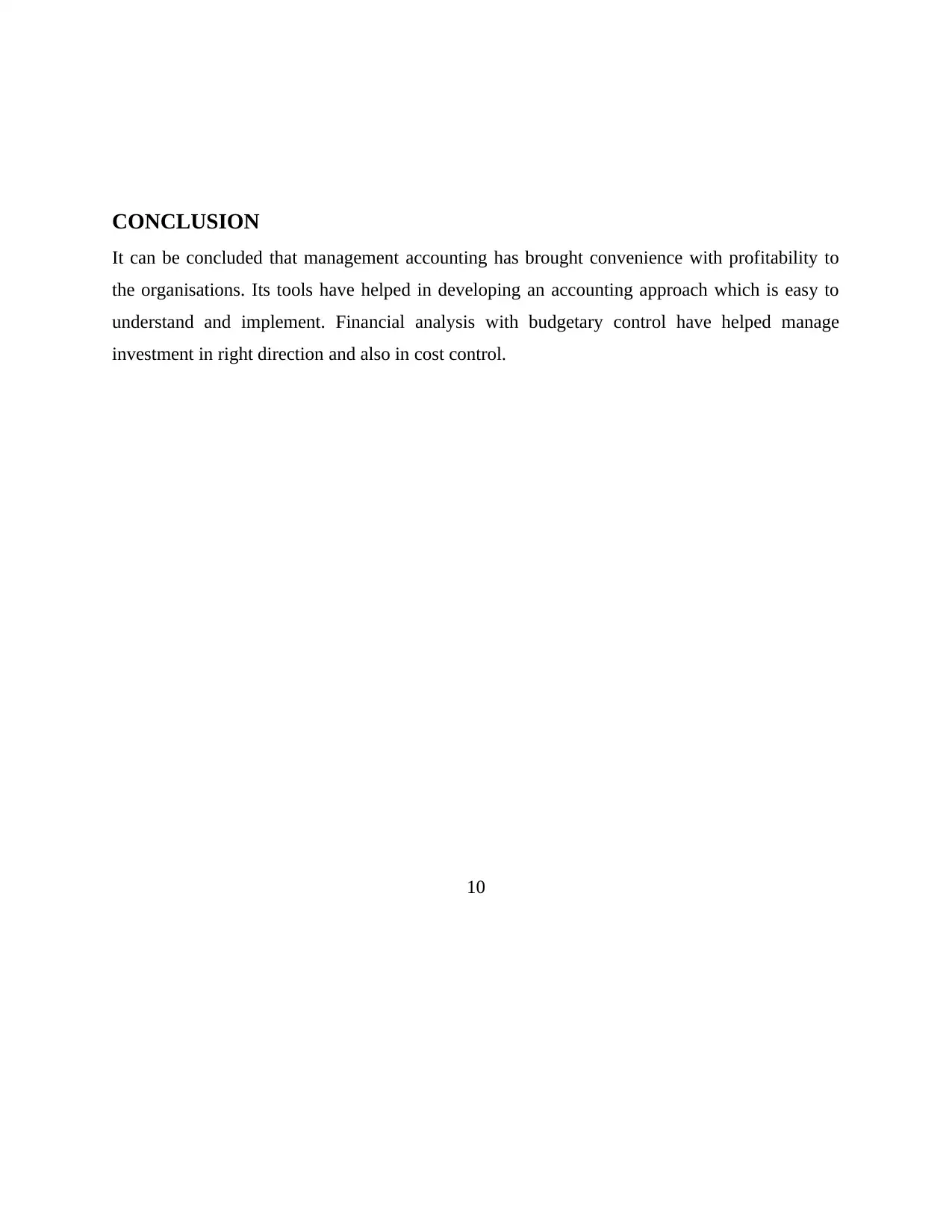
CONCLUSION
It can be concluded that management accounting has brought convenience with profitability to
the organisations. Its tools have helped in developing an accounting approach which is easy to
understand and implement. Financial analysis with budgetary control have helped manage
investment in right direction and also in cost control.
10
It can be concluded that management accounting has brought convenience with profitability to
the organisations. Its tools have helped in developing an accounting approach which is easy to
understand and implement. Financial analysis with budgetary control have helped manage
investment in right direction and also in cost control.
10
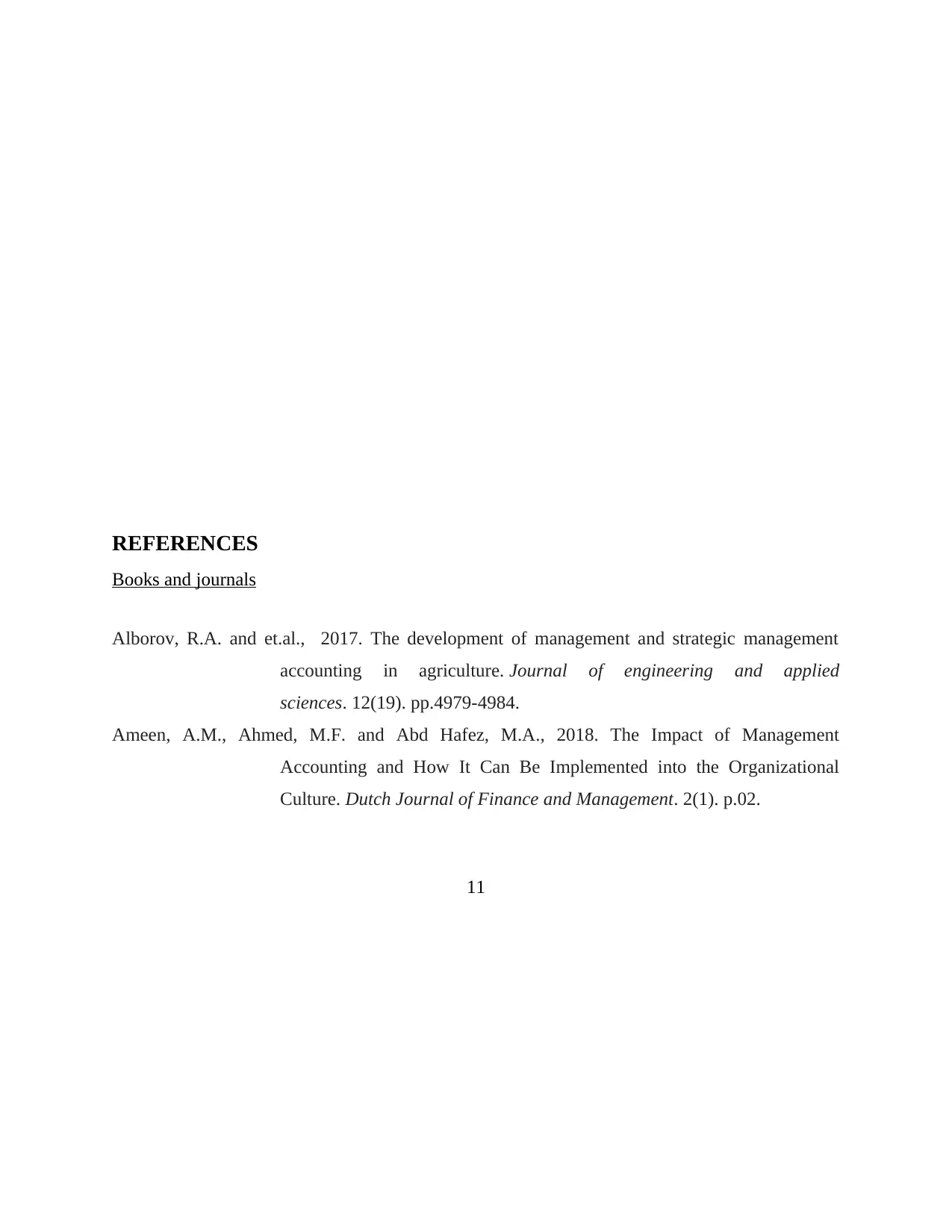
REFERENCES
Books and journals
Alborov, R.A. and et.al., 2017. The development of management and strategic management
accounting in agriculture. Journal of engineering and applied
sciences. 12(19). pp.4979-4984.
Ameen, A.M., Ahmed, M.F. and Abd Hafez, M.A., 2018. The Impact of Management
Accounting and How It Can Be Implemented into the Organizational
Culture. Dutch Journal of Finance and Management. 2(1). p.02.
11
Books and journals
Alborov, R.A. and et.al., 2017. The development of management and strategic management
accounting in agriculture. Journal of engineering and applied
sciences. 12(19). pp.4979-4984.
Ameen, A.M., Ahmed, M.F. and Abd Hafez, M.A., 2018. The Impact of Management
Accounting and How It Can Be Implemented into the Organizational
Culture. Dutch Journal of Finance and Management. 2(1). p.02.
11

Burritt, R.L. and et.al.,2019. Diffusion of environmental management accounting for cleaner
production: Evidence from some case studies. Journal of Cleaner
Production. 224. pp.479-491.
Hiebl, M.R. and Richter, J.F. 2018. Response rates in management accounting survey
research. Journal of Management Accounting Research. 30(2). pp.59-79.
Honggowati, S. and et.al., 2017. Corporate governance and strategic management accounting
disclosure. Indonesian Journal of Sustainability Accounting and
Management. 1(1). pp.23-30.
Joshi, S. and Li, Y. 2016. What is corporate sustainability and how do firms practice it? A
management accounting research perspective. Journal of Management
Accounting Research. 28(2). pp.1-11.
Kostyukova, E.I. and et.al., 2018. Improvement cost management system for management
accounting. Research Journal of Pharmaceutical, Biological and
Chemical Sciences. 9(2). pp.775-779.
Maas, K., Schaltegger, S. and Crutzen, N. 2016. Integrating corporate sustainability assessment,
management accounting, control, and reporting. Journal of Cleaner
Production. 136. pp.237-248.
Mahmoudian, F. and et.al., 2020. Inter-and intra-organizational stakeholder arrangements in
carbon management accounting. The British Accounting Review,
p.100933.
Qian, W., Hörisch, J. and Schaltegger, S. 2018. Environmental management accounting and its
effects on carbon management and disclosure quality. Journal of Cleaner
Production. 174. pp.1608-1619.
12
production: Evidence from some case studies. Journal of Cleaner
Production. 224. pp.479-491.
Hiebl, M.R. and Richter, J.F. 2018. Response rates in management accounting survey
research. Journal of Management Accounting Research. 30(2). pp.59-79.
Honggowati, S. and et.al., 2017. Corporate governance and strategic management accounting
disclosure. Indonesian Journal of Sustainability Accounting and
Management. 1(1). pp.23-30.
Joshi, S. and Li, Y. 2016. What is corporate sustainability and how do firms practice it? A
management accounting research perspective. Journal of Management
Accounting Research. 28(2). pp.1-11.
Kostyukova, E.I. and et.al., 2018. Improvement cost management system for management
accounting. Research Journal of Pharmaceutical, Biological and
Chemical Sciences. 9(2). pp.775-779.
Maas, K., Schaltegger, S. and Crutzen, N. 2016. Integrating corporate sustainability assessment,
management accounting, control, and reporting. Journal of Cleaner
Production. 136. pp.237-248.
Mahmoudian, F. and et.al., 2020. Inter-and intra-organizational stakeholder arrangements in
carbon management accounting. The British Accounting Review,
p.100933.
Qian, W., Hörisch, J. and Schaltegger, S. 2018. Environmental management accounting and its
effects on carbon management and disclosure quality. Journal of Cleaner
Production. 174. pp.1608-1619.
12
Paraphrase This Document
Need a fresh take? Get an instant paraphrase of this document with our AI Paraphraser
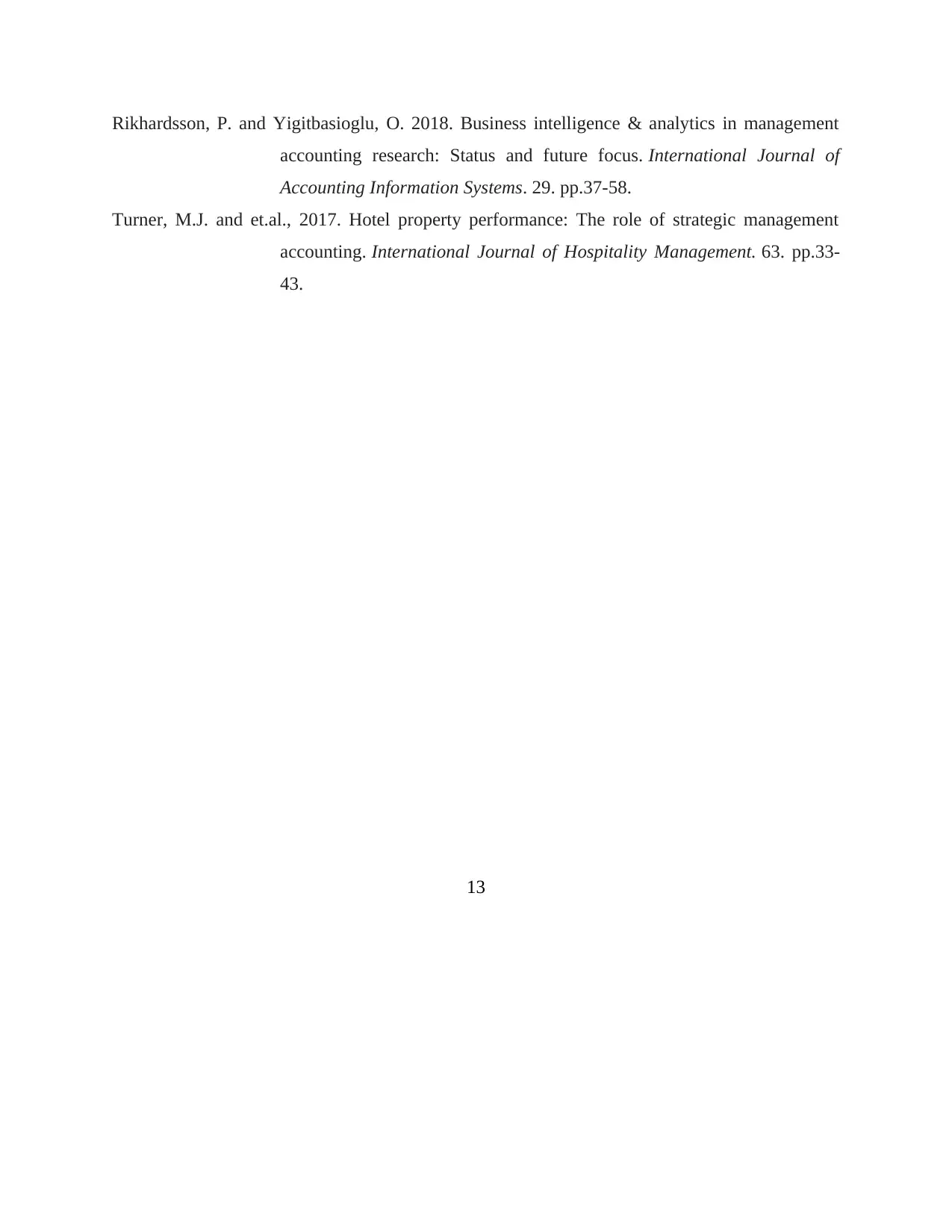
Rikhardsson, P. and Yigitbasioglu, O. 2018. Business intelligence & analytics in management
accounting research: Status and future focus. International Journal of
Accounting Information Systems. 29. pp.37-58.
Turner, M.J. and et.al., 2017. Hotel property performance: The role of strategic management
accounting. International Journal of Hospitality Management. 63. pp.33-
43.
13
accounting research: Status and future focus. International Journal of
Accounting Information Systems. 29. pp.37-58.
Turner, M.J. and et.al., 2017. Hotel property performance: The role of strategic management
accounting. International Journal of Hospitality Management. 63. pp.33-
43.
13

14
1 out of 21
Related Documents
Your All-in-One AI-Powered Toolkit for Academic Success.
+13062052269
info@desklib.com
Available 24*7 on WhatsApp / Email
![[object Object]](/_next/static/media/star-bottom.7253800d.svg)
Unlock your academic potential
© 2024 | Zucol Services PVT LTD | All rights reserved.





